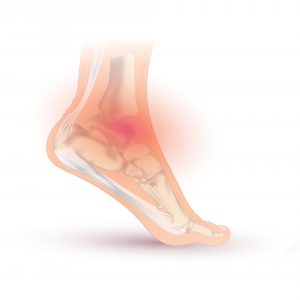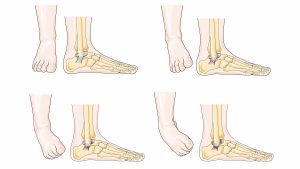
Erasmus+
“This project has been funded with support from the European Commission. This publication reflects the views only of the author, and the Commission cannot be held responsible for any use which may be made of the information contained therein”
Lateral Ankle Sprain injuries in soccer – Prevention Strategies
Upon completion of this module the reader will be able to:
- Understand basic anatomy and functional anatomy for the ankle complex.
- Understand ankle sprain epidemiology
- Understand the mechanisms for the ankle sprains.
- Determine common risk factors that can lead to ankle sprains injuries.
Review the «Anatomy and Functional of the ankle joint» topic and the «Injury prevention strategies» topic first. Then read the “Anatomy of ankle joint”. Read the description of the “ Lateral Ankle Sprain injuries in soccer – Prevention strategies” and the corresponding presentation and then follow the proposed videos for some ideas of “ Lateral Ankle Sprain injuries prevention exercises”. End the session with the “Bibliography and the additional learning materials” and assess your understanding with the “Lateral Ankle Sprain injuries in soccer” quiz.
Anatomy and function of the Anterior Talofibular ligament (ATFL)
The Anterior Talofibular ligament (ATFL) is the most frequently injured of the lateral ligaments. The ATFL lies on the dorsolateral aspect of the foot, it starts from the lateral malleolus anteriorly and medially toward the talus at an angle of approximately 45° from the frontal plane. The ATFL prevents anterior displacement of the talus from the mortise and excessive inversion and internal rotation of the talus relative to the tibia. The strain in the ATFL increases as the ankle moves from dorsiflexion into plantar flexion.

By Injury map – edit Injury Map – Free Human Anatomy Images and Pictures. Retrieved on 2019-08-10., CC BY 4.0, https://commons.wikimedia.org/w/index.php?curid=69188254
Τhe proposed preventive strategies for ankle injuries include four phases and they propose specific preventive exercises :
Phase I : Muscular conditioning to restore dysfunctional movement patterns that can impede performance
1a. Inhibition: Inhibit through foam rolling the over-activate muscles: gastrocnemius & soleus.
1b.Muscle lengthen: Specific lengthening exercises with static or neuromuscular stretches for gastrocnemius & soleus.
Phase II: Muscular performance: Modifying strength and conditioning movements
Specific activation exercises through strengthening exercises or positional stabilization exercises for the anterior and posterior tibialis. Core strength.
Phase III: Functional exercise: Building efficient movement patterns
Starting with proper athletic position, always warm up before playing, perform different Squats and Walking Lunges. Do balance, agility-changing direction and jumping and landing exercises.
Lateral Ankle Sprain injuries in soccer – Prevention Strategies
Injury epidemiology
Injuries to the lateral ligaments of the ankle complex are very frequent in soccer players. Of all injuries 17 to 20% were ankle sprains and the incidence varied between 1.7 to 2.0 ankle injuries per 1,000 hours of exposure (Ekstrand et al. 1990). More than 23 000 ankle sprains have been estimated to occur per day in the United States, which equates to one sprain per 10 000 people daily. Lateral ankle sprains are thought to be suffered by men and women at approximately the same rates. The most common predisposition to suffering a lateral ankle sprain is the history of at least one previous ankle sprain.
Mechanisms of injury

Excessive inversion and internal rotation of the rearfoot, coupled with external rotation of the lower leg, results in strain to the lateral ankle ligaments. If the strain in any of the ligaments exceeds the tensile strength of the tissues, ligamentous damage occurs. Increased plantar flexion at initial contact appears to increase the likelihood of suffering a lateral ankle sprain. The ATFL is the first ligament to be damaged during a lateral ankle sprain, followed most often by the calcaneofibular ligament (CFL).
Lateral Ankle Sprain injuries prevention exercises based on previous phases:
Phase I : Muscular conditioning to restore dysfunctional movement patterns that can impede performance
Phase ΙI : Muscular performance – Modifying strength and conditioning movements patterns
Phase III: Functional exercise – Building efficient movement pattern
Bibliography and the additional learning materials
- First try to increase your joint flexibility using stretches
- Strengthen you muscles, especially the lateral ankle muscles, like the peronei muscles.
- Always exercise in a pain-free range of motion. Exercises or parts of exercise that lead to pain should be avoided.
- Improve your ability to balance and land on the ground
- Ekstrand J1, Tropp H. The incidence of ankle sprains in soccer Foot Ankle.1990 Aug;11(1):41-4.
- Garrick J G. The frequency of injury, mechanism of injury, and epidemiology of ankle sprains. Am J Sports Med. 1977;5:241–242
- Jay Hertel. Functional Anatomy, Pathomechanics, and Pathophysiology of Lateral Ankle Instability. J Athl Train. 2002 Oct-Dec; 37(4): 364–375.
- Payne K A, Berg K, Latin R W. Ankle injuries and ankle strength, flexibility, and proprioception in college basketball players. J Athl Train. 1997;32:221–225.
- Docherty CL, Moore JH, Arnold BL. Effects of strength training on strength development and joint position sense in functionally unstable ankles. J Athl Train. 1998;33:310-314.
- Rozzi SL, Lephart SM, Sterner R, Kuligowski L. Balance training for persons with functionally unstable ankles. J Orthop Sports Phys Ther. 1999;29:478-486.
[ays_quiz id=’24’]
Erasmus+
“This project has been funded with support from the European Commission. This publication reflects the views only of the author, and the Commission cannot be held responsible for any use which may be made of the information contained therein.”
